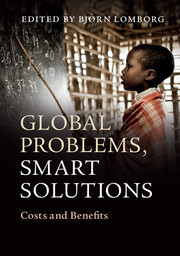Book contents
- Frontmatter
- Contents
- List of Figures
- List of Tables
- List of Contributors
- Acknowledgments
- Selected abbreviations and acronyms
- Introduction
- Part I The Solutions
- 1 Armed Conflicts
- 2 Ecosystems and Biodiversity
- 3 Chronic Disease
- 4 Climate Change
- 5 Education
- 6 Hunger and Malnutrition
- 7 Infectious Disease, Injury, and Reproductive Health
- 8 Natural Disasters
- 9 Population growth
- 10 Water and Sanitation
- 11 Corruption and Policy Reform
- 12 Trade Barriers and Subsidies
- Part II Ranking the Opportunities
- Conclusion: Making Your Own Prioritization
- Index
- References
6 - Hunger and Malnutrition
Published online by Cambridge University Press: 05 June 2014
- Frontmatter
- Contents
- List of Figures
- List of Tables
- List of Contributors
- Acknowledgments
- Selected abbreviations and acronyms
- Introduction
- Part I The Solutions
- 1 Armed Conflicts
- 2 Ecosystems and Biodiversity
- 3 Chronic Disease
- 4 Climate Change
- 5 Education
- 6 Hunger and Malnutrition
- 7 Infectious Disease, Injury, and Reproductive Health
- 8 Natural Disasters
- 9 Population growth
- 10 Water and Sanitation
- 11 Corruption and Policy Reform
- 12 Trade Barriers and Subsidies
- Part II Ranking the Opportunities
- Conclusion: Making Your Own Prioritization
- Index
- References
Summary
Introduction: the challenge of hunger and undernutrition
Current estimates suggest that there are approximately 925 million hungry people in the world. Just under 180 million pre-school children are stunted – that is, they are the victims of chronic undernutrition. This deprivation is not because of insufficient food production. Approximately 2,100 kcal/person/day, provides sufficient energy for most daily activities; current per capita global food production, at 2,796 kcal/person/day, is well in excess of this requirement. Given that there is more than enough food in the world to feed its inhabitants, global hunger is not an insoluble problem.
Deprivation in a world of plenty is an intrinsic rationale for investments that reduce hunger and undernutrition; our focus in this chapter, as with previous Copenhagen Consensus papers on this topic, Behrman et al. (2004) and Horton et al. (2008), is on the instrumental case for doing so. In its simplest form, the central argument of this chapter is that these investments are simply good economics. Our solutions, however, represent a partial departure from those earlier Copenhagen Consensus papers. First, we re-introduce attention to solutions to hunger with a focus on investments that will increase global food production. This might seem strange given our observation that global food production exceeds global food needs. But as we argue in this chapter, these investments are needed for two reasons: to lower prices so as to make food more affordable; and because, given the consequences of climate change, there can be no complacency regarding global food production. Second, previous Copenhagen Consensus papers on hunger and undernutrition have considered very specific interventions that focus on single dimensions of undernutrition. In this chapter, we examine the economic case for bundling these. Our proposed investments are:
Investment 1: Accelerating yield enhancements
Investment 2: Market innovations that reduce hunger
Investment 3: Interventions that reduce the micronutrient malnutrition and reduce the prevalence of stunting
We begin with background material that contextualizes our proposed solutions:
What are the causes of hunger?
How many hungry and undernourished people are there in the world?
And what are the likely trends in hunger over the next twenty-five–thirty-five years?
We then describe our three proposed investments, explaining how each addresses the problems of hunger and undernutrition and describing their costs and benefits. Caveats and cautions are noted in the third section and our concluding section summarizes the case for these investments.
- Type
- Chapter
- Information
- Global Problems, Smart SolutionsCosts and Benefits, pp. 332 - 389Publisher: Cambridge University PressPrint publication year: 2013
References
- 31
- Cited by



